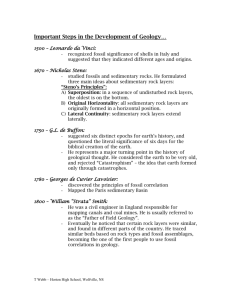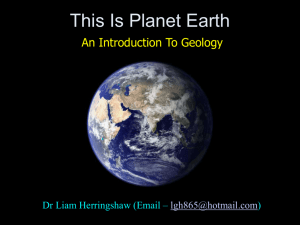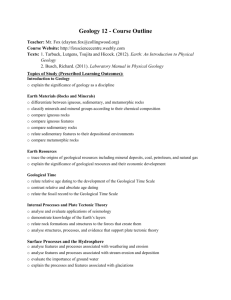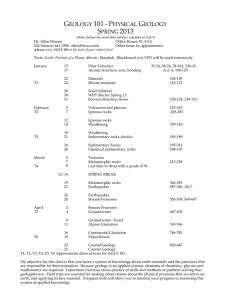Document 13471530
advertisement
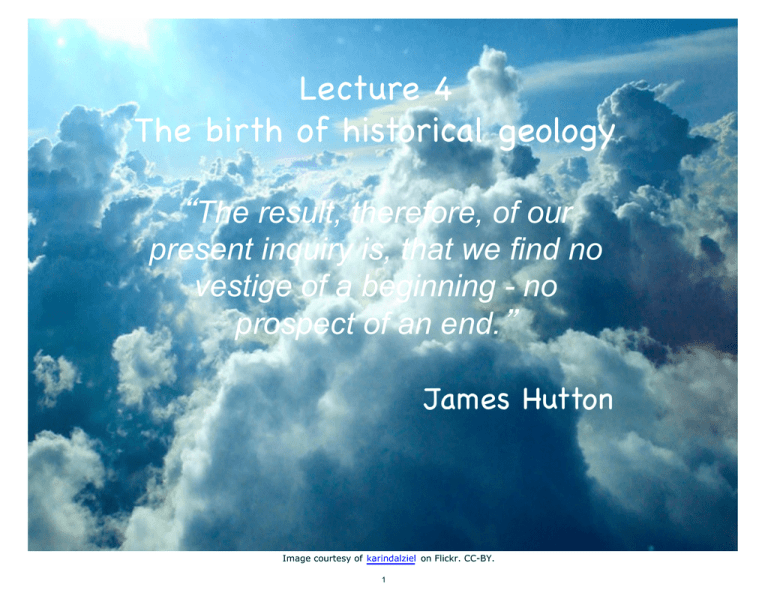
Lecture 4 The birth of historical geology “The result, therefore, of our present inquiry is, that we find no vestige of a beginning - no prospect of an end.” James Hutton Image courtesy of karindalziel on Flickr. CC-BY. 1 The Rise of Historical Geology In the late-18th century, there was increasing interest in studying rock formations with a view to understanding the nature of the earth Interest focused on the (frequently horizontal) bands of “sedimentary” rocks that appeared to have been laid down as sediments in water Early attempts to map the different layers or strata of sedimentary rocks were the key to an emerging understanding that the earth might have a discoverable history 2 Sedimentary strata, Charmouth, England Photo courtesy of kevinzim on Flickr. 3 Nicolas Steno (Niels Stensen), 1638-86 Danish anatomist and geologist Traveled widely in Europe & created a ‘Cabinet of Curiosities’ for Grand Duke of Tuscany Made observations that laid the foundations of geology 4 ‘Tongue Stones’ ’ In his Dissertationis prodromus (1669), Steno argued that ‘tongue stones’ were sharks’ teeth embedded in rock He established some basic principles of study of rock strata, or stratigraphy 5 3 principles of stratigraphy Principle of superposition "...at the time when any given stratum was being formed, all the matter resting upon it ?);G=1,)6,<0-:-.7:-)<<0-<15-?0-6 the lower stratum was being formed, none of the upper strata existed…" Principle of original horizontality Principle of lateral continuity 6 James Hutton, 1726-1797 )27:F/=:-16<0- Scottish Enlightenment Explored nature and origins of different types of rocks (igneous, sedimentary, metamorphic) ‘Hutton Section’, Salisbury Crag, Edinburgh ‘Hutton Unconformity”, Inchbonny, Jedburgh, 1787 Theory of the Earth, 1788 7 Arthur’ ’s Seat, Edinburgh, Scotland Photo courtesy of koalie on Flickr. 8 Main stages in formation of Arthur’’s Seat (modern view) 1. Thin layers of mud & sand are deposited in shallow tropical seas 2. A series of volcanoes erupts through the older sedimentary rocks above, forming cones of basaltic lavas & ash 3. %0->74+)67-;->-6<=)44A*-+75--@<16+<)6,):-<0-6G77,-, & buried under more muddy sediments 4. More molten rock is then extruded between the sedimentary rocks to form “sills” 5. Earth movements fold the rocks, tilting the entire area to the east 6. Millions of years of erosion wear down the rocks, leaving the (relatively hard) former volcanic plugs as peaks, one of which is Arthur’s seat. 9 “Hutton’’s Section” ”, Salisbury Crags, Edinburg Photo courtesy of Patrick_Down on flickr. CC-BY-NC. 10 “Hutton Unconformity” ”, Jedburgh, Scotland Hutton toured the Berwickshire coast with John Playfair (1788), F6,16/<0-;)5-;-9=-6+- of rocks in several places Greywacke (vertical layers), with conglomerate above and Old Red Sandstone above that Playfair: “the mind seemed to grow giddy by looking so far into the abyss of time” 11 Hutton’’s unsettling conclusion “The result, therefore, of our present #'$+%&&). !(%&! beginning - no prospect of an end.” James Hutton, Paper to Royal Society of Edinburgh, 1788 12 The (re-)birth of stratigraphy Hutton’s radical ideas (like many other ideas coming out of Edinburgh at the time) were not immediately taken up by English geologists. Instead, around 1800 stratigraphy began to (re-)emerge in England out of a set of altogether more practical, “down-toearth” needs 13 William Smith (1769-1839) “Strata” Smith Worked as surveyor, e.g., for Somerset Coal Canal Company 1799, 1st geological map of Bath area 1815, 1st geological map of Britain 14 Smith’;F:;< geological map of Britain (1815) What are the areas outlined in black? 15 The popular craze for geology in England, 1815-1840 Professional & popular interest in geology grew enormously in England in the early-19th century What factors do you suppose made this subject so popular? 16 The popular craze for geology The First Industrial Revolution – Mining (the need to locate coal & other minerals) – The canals (the need to identify the best routes) – The railways (the need to create cuttings, tunnels, etc) Accessibility – This was a practical subject, easily accessible to people from all walks of life – All you needed were good boots & a hammer The wonderful things you could dig up 17 A tale of two friends: Henry de la Beche and Mary Anning Many different types of people – workers and artisans, middle class professionals, upper class gentlemen – were attracted into geology in the early-19th century The contrasting careers of two geologist friends who grew up in one small English seaside town illustrate some of the attractions – and challenges – of geology at the time 18 The town: Lyme Regis, Dorset Photo courtesy of tricky on Flickr. 19 Ammonite pavement, Lyme Regis Photo courtesy of premasagar on Flickr. CC-BY-NC. 20 Henry de la Beche, 1796 - 1855 $767.)6):5A7.F+-: Grew up in Lyme Regis Elected to Royal Society aged 19 Joined Geological Society of London at age 21 Head of Geological Survey of Great Britain (1835) Director, Royal School of Mines (1851) Friend of Mary Anning 21 Mary Anning, 1799 - 1847 Daughter of a cabinet maker in Lyme Regis Helped father fossil hunt to supplement family income Made a string of important .7;;14F6,; Granted ‘annuity’ by BAAS (1831) Granted ‘Honorary’ Membership of Geological Society of London (1846) 22 Two of Mary Anning’’s key fossil 8-$1 Ichthyosaur Photo courtesy of JF Sebastian on Flickr. Plesiosaur Photo courtesy of listentoreason on Flickr. 23 Lady Sivester, 1824 ". . . the extraordinary thing in this young woman is that she has made herself so thoroughly acquainted )&&% &&&! &%. % +! % % !)%&!)&&$&+! .*%& bones on a frame with cement and then makes drawings and has them engraved. . . It is certainly a wonderful instance of divine favour - that this poor, ignorant girl should be so blessed, for by reading and application she has arrived to that degree of knowledge as to be in the habit of writing and talking with professors and other clever men on the subject, and they all acknowledge that she understands more of the science than anyone else in this kingdom." 24 Posthumous celebrity “She sells seashells on the seashore The shells she sells are seashells, I'm sure So if she sells seashells on the seashore Then I'm sure she sells seashore shells.” Terry Sullivan, 1908 25 Anning’’s home - now Lyme Regis Museum Photo courtesy of Reading Tom on Flickr. CC-BY. 26 De la Beche’s Response De la Beche was an important geological surveyor, not a palaeontologist BUT…he made wonderful observations on his friend’s palaeontological discoveries, not least in a series of water-color paintings and cartoons…. 27 28 “Awful Changes” “You will at once perceive," continued Professor Ichthyosaurus, "that the skull before =;*-476/-,<7;75-7.<0-47?-:7:,-:7.)615)4;<0-<--<0):->-:A16;1/61F+)6< <0-87?-:7.<0-2)?;<:1G16/)6,)4<7/-<0-:1<;--5;?76,-:.=407?<0-+:-)<=:- could have procured food." 29 “Awful Changes””: The impact of the new geology %! &%&!%%. % captured the popular imagination in the early 19th century – in England, and elsewhere…. 30 Puzzle for tomorrow What’s this, and what does it have to do with Massachusetts? Photo courtesy of aaron.knox on Flickr. 31 MIT OpenCourseWare http://ocw.mit.edu STS.009 Evolution and Society Spring 2012 For information about citing these materials or our Terms of Use, visit: http://ocw.mit.edu/terms.

